
The Marantaceae are a family, the arrowroot family, of flowering plants consisting of 31 genera and around 530 species, defining it as one of the most species-rich families in its order. Species of this family are found in lowland tropical forests of Africa, Asia, and the Americas. The majority (80%) of the species are found in the American tropics, followed by Asian (11%) and African (9%) tropics. They are commonly called the prayer-plant family and are also known for their unique secondary pollination presentation.

François Gagnepain was a French botanist. The standard botanical author abbreviation Gagnep. is applied to plants described by Gagnepain.

Antidesma is a genus of tropical plant in the family Phyllanthaceae formally described by Linnaeus in 1753. It is native to tropical Africa, S + E + SE Asia, Australia, and various oceanic islands. The greatest diversity occurs in Southeast Asia.

Bombax is a genus of mainly tropical trees in the mallow family. They are native to western Africa, the Indian subcontinent, Southeast Asia, and the subtropical regions of East Asia and northern Australia. It is distinguished from the genus Ceiba, which has whiter flowers.
Pantadenia is a genus of plants under the family Euphorbiaceae first described as a genus in 1925. It is native to Madagascar and Indochina.
- Pantadenia adenantheraGagnep. - Cambodia, Laos, Thailand, Vietnam
- Pantadenia chauvetiae(Leandri & Capuron) G.L.Webster - Madagascar
- Pantadenia gervaisiiR.Rabev. & McPherson - Madagascar
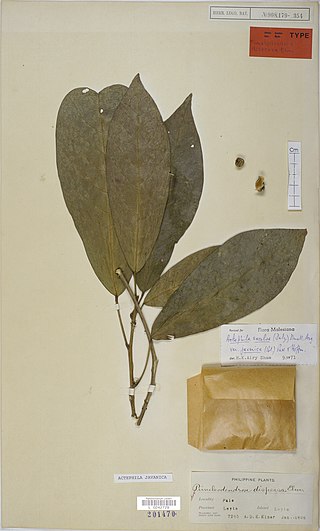
Actephila is a genus of plants in the family Phyllanthaceae, first described as a genus in 1826. It is one of 8 genera in the tribe Poranthereae, and is most closely related to Leptopus. The name of the genus is derived from two Greek words, akte, "the seashore", and philos, "loving". It refers to a coastal habitat.

Karl Moritz Schumann was a German botanist.

Schumannianthus dichotomus, also known as 'cool mat', is a species of flowering plant first described by Roxburgh, with its current name after Gagnepain. The species belongs to the family Marantaceae and no subspecies are listed.
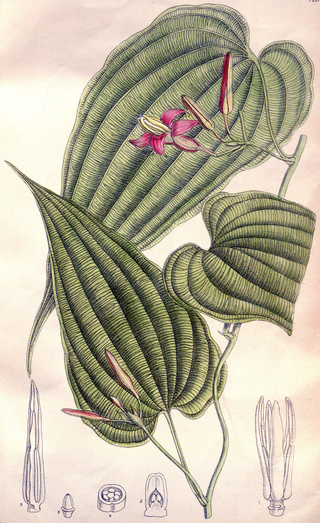
Stemona is a genus of vines and subshrubs in the family Stemonaceae, described as a genus in 1790.

Laportea is a genus of plants in the family Urticaceae. They are herbaceous, either annual or perennial. Like many plants of the Urticaceae, they have stinging hairs. There are stinging and non-stinging hairs on the same plant. The genus was named after the French naturalist Francis de Laporte de Castelnau.
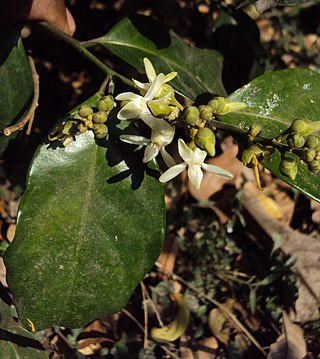
Xanthophyllum is a genus of about 109 species of trees and shrubs, of the plant family Polygalaceae;. The generic name is from the Greek meaning "yellow leaf", referring to how the leaves are often yellow when dry. In Borneo it is known as minyak berok in Malay or nyalin in the Iban language.

Entada is a genus of flowering plants in the family Fabaceae, in the mimosoid clade of the subfamily Caesalpinioideae. It consists of some 30 species of trees, shrubs and tropical lianas. About 21 species are known from Africa, six from Asia, two from the American tropics and one with a pantropical distribution. They have compound leaves and produce exceptionally large seedpods of up to 1.5 metres (4.9 ft) long. Their seeds are buoyant and survive lengthy journeys via rivers and ocean currents, to eventually wash up on tropical beaches.

Glossocardia is a genus of flowering plants in the daisy family. It is native to Asia and Australia.
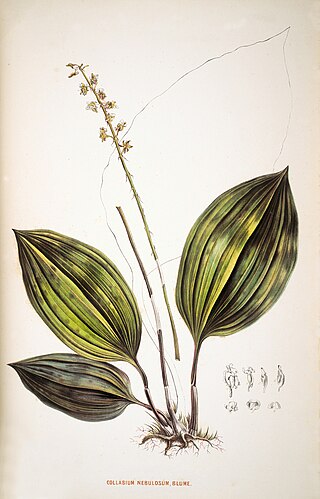
Collabium is a genus of flowering plants in the orchid family, Orchidaceae. Species of Collabium are typically terrestrial and grow under shade in forests. They are distributed in southeast Asia from the Himalayas in India, Burma to China, and to the island groups in Malaysia, the Philippines, the Solomon Islands, Vanuatu, New Caledonia, and Fiji.
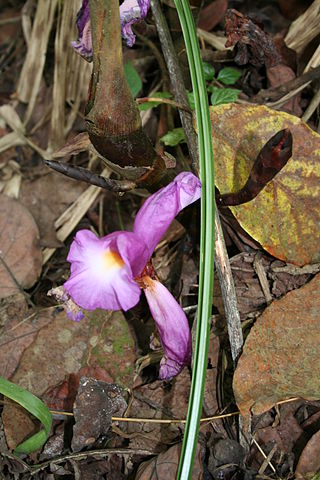
Aframomum is a genus in the ginger family, Zingiberaceae. It is widespread across tropical Africa as well as on some islands of the Indian Ocean. It is represented by approximately 50 species. It is larger than other genera in its family. Its species are perennials and produce colorful flowers.
Clinogyne is a former genus of monocotyledonous plants, which have been moved to other genera. Its species included the following:

Juncus dichotomus is a monocot in the Juncaceae family of rushes. The plant is native to the Americas in temperate zones but has been introduced to other parts of the world. Juncus dichotomus often is found in very moist areas and where rainfall is a common occurrence. It is often most recognizable in the spring and summer months due to its conspicuous flowers and infructescence.
Paul Alfred Pételot (1885–1965) was a French botanist and entomologist, whose primary scholarly focus was on medicinal plants in Southeast Asia. Some sources list his date of death as 1940, but several herbaria specimens are recorded as being collected by him up until 1944 including Carex kucyniakii (1944), Teijsmanniodendron peteloti (1941), Amalocalyx microlobus (1941), Amalocalyx microlobus (1942), Trichosanthes kerrii (1944) and Siraitia siamensis (1944). In addition, he continued to author publications through the 1950s, though it is possible these are posthumous.
Petelotiella is a monotypic genus of flowering plants belonging to the family Urticaceae. It contains just one species, Petelotiella tonkinensis.















